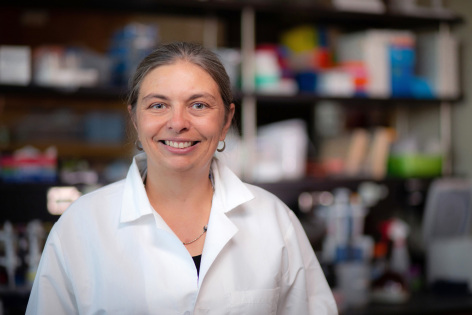
Yandeau-Nelson inside her lab (Larger image). Photos by Christopher Gannon, Iowa State University
AMES, Iowa – Scientists are working to bioengineer a common defense mechanism that most plants develop naturally to protect against drought, insects and other environmental stresses.
The goal is to identify the genetic structure of a plant cuticle and create a roadmap for breeding plants with designer cuticles that can respond to changing climates. The cuticle is a thin, waxy layer that provides a physical barrier between the plant and its environment. The work also has potential biorenewable applications for developing value-added chemicals with industrial functions.
Marna Yandeau-Nelson, an associate professor of genetics, development and cell biology at Iowa State University, is leading the cross-disciplinary team that includes researchers from Iowa State, the University of Delaware and University of Nebraska-Lincoln. The project, which is funded by a $2.65-million National Science Foundation grant, includes a unique partnership with Iowa State’s Science Bound program to provide research opportunities for underrepresented students.
“If we understand what genes are required for certain compositions and what compositions of the cuticle protect against different stresses, then we have the ability for applied breeding for the production of designer cuticles with important protective functions,” Yandeau-Nelson said.
Why build a cuticle from scratch?
The research will focus on the cuticle of a corn plant. While many of the genes that contribute to the cuticle have been identified, researchers do not have a good understanding of the specific functions of each gene and how they all work together.
To answer these questions, Yandeau-Nelson and her colleagues have proposed building a cuticle from scratch in the root of a plant – an area that generally does not produce a cuticle – and in yeast. It’s an ambitious approach that builds upon existing research by Yandeau-Nelson and Basil Nikolau, an emeritus professor of biochemistry, biophysics and molecular biology at Iowa State.
Nikolau’s foundational work establishes a platform for making a synthetic cuticle in yeast and will allow the research team to test hundreds of different combinations of enzyme-encoding genes, Yandeau-Nelson said. Researchers at the University of Delaware, led by assistant professor Erin Sparks, will apply their expertise in root synthetic biology to engineer plants to express different regulators to induce the production of cuticle chemicals in plant roots.
“That’s the value and really the creativity in what we’re proposing. We’re starting with nothing, with a part of the plant, or a microbe, that doesn’t make a cuticle,” Yandeau-Nelson said. “This means we can start adding genes to determine the regulatory genes, transcription factors and pathways necessary to make this important structure in the plant. We will truly understand the components and intricacies of a pathway, if we can build it from scratch.”
Training scientists

Biochemistry graduate student Dirk Winkelman works on extraction of cuticle-like metabolites under the fume hood inside Marna Yandeau-Nelson’s lab in the Molecular Biology Building (Larger image).
Yandeau-Nelson and students in her lab will grow and examine the plant roots to identify how different gene combinations contribute to the cuticle and other plant characteristics. Rajib Sahah, associate professor at the University of Nebraska-Lincoln, will take the plant and microbe data from the lab to model pathways and build predictive models.
By working side-by-side with students on this project, Yandeau-Nelson and her colleagues are helping train the next generation of scientists. As part of that training, Alexis Campbell, director of ISU’s Science Bound program, is working with researchers to offer an integrated, online course and professional development opportunities for underrepresented students in STEM fields. Students who complete the course will have an opportunity to participate in a summer research cohort at one of the three universities.
“It was important that this project include an educational component for students to do really meaningful research,” Yandeau-Nelson said. “Students will get hands-on expertise in molecular biology, molecular genetics, biochemistry, metabolism, modeling and data analysis.”